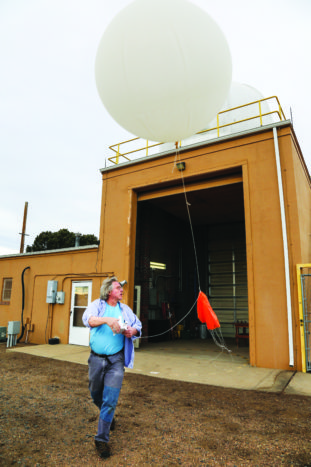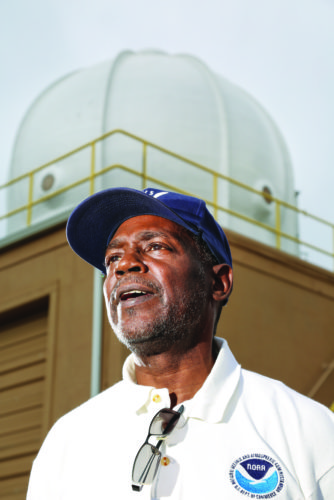
NWS Meteorologist Robert Koopmeiners exits the observation building with weather balloon and parachute in tow, radiosonde in hand. Photo by John Fernandez
When it was an airport, Stapleton hosted a three-pronged National Weather Service (NWS) office: an upper atmosphere weather balloon program; a weather forecasting office; and weather observations related to the airport. Only the weather balloon program remains of what used to be called the Denver Weather Forecast Office headquartered on and adjacent to Stapleton International Airport. When Stapleton closed in 1995, official weather observations moved to DIA. In 1995, Stapleton’s forecast function moved to Boulder’s NWS facility.
But the weather balloon program persists and is now in its 79th year. Balloons are launched at zero hundred and 12 hundred hours “zulu” time every day of the year from a rundown brick building topped with a mini dome located a few hundred feet south of The Urban Farm administration building next to Smith Road. Those zulu times translate to 5am and 5pm taking into account daylight savings time. The Stapleton station is one of 92 operated by the NWS in North America and the Pacific Islands and is part of a global network of more than 800 stations.
The instrumentation carried aloft measures temperature, pressure, relative humidity, position, wind speed and direction. The data are inputs to computer-based weather forecast models, weather and climate change research, and local severe storm, aviation, fire weather and marine forecasts. Data geeks can access the information within 12 hours on a website such as Unisys Weather, which posts colorful “thermodynamic” maps.

Byron Louis, who retired as a Data Acquisitions Program Manager in 2013, recalls his NWS career with fondness and gratitude.
Chris O’Brien, a NWS contractor, arrives for his daily shifts at 4:15am and 4:15pm. He assembles the helium-filled balloon, calibrates the electronics and attaches the radiosonde, a one-pound, expendable instrument package. Depending on wind conditions, he launches the balloon from the south- or north-facing side of the observation building. He also checks to make sure neither lightning nor nearby thunderstorms will interfere with the launch.
A simple hand toss gets the balloon ascending at a rate of a thousand feet a minute. The radiosonde follows the balloon by means of a 100-foot tether, a separation mandated by the need to minimize contamination of the temperature measurements from heat shedding off the balloon skin. As the balloon rises, O’Brien monitors the arrival of data and checks against “frequency drift” in the signals coming from the radiosonde. A launch reaching an air pressure level of 400 millibars or about 23,000 feet is deemed acceptable. Failure to reach that level requires the launch of a second balloon.
The flight typically continues to about 100,000 feet where the five-foot diameter balloon at ground level has expanded to the size of a two-car garage. There, it bursts and the radiosonde returns to earth by parachute. Perhaps a quarter of the radiosondes are returned to the NSW. Landing sites for Stapleton-launched balloons have been as close as the other side of I-70 and as far away as Kansas.
Weather balloon launching at Stapleton has been a constant for going on 80 years. What has changed are the organizations and technology used to acquire, disseminate and analyze the weather data. The first official weather observation in Denver occurred Nov. 20, 1871, under the auspices of the U.S. Army Signal Service. NWS was made a bureau in 1891 and, in 1931, a weather observation office was established at Stapleton Airfield. Upper air observations began in 1939 at Stapleton and have continued uninterrupted except when transferred to the Air Corps at Lowry Field during World War II.
Meteorological observers such as Byron Louis and Paul Gard, who both began work at the Stapleton office in the 1970s, recall that the job of the balloon launcher was far more manual and hectic in the days before computer automation. Louis, who retired from the NWS in 2013, described the challenge of doing data analysis with a temperature slide rule directly on the recorder printer sheets spitting out numbers at the rate of a quarter inch per minute. He also shook his head in remembering the need to squint at the balloon through a theodolite to record elevation and azimuth each minute of the two-hour flight. This was done monthly to crosscheck the accuracy of the radar used to track the position of the balloon. Now this is all done automatically using GPS and the meteorological data are transmitted each second to the ground station—a volume not possible in a manual system.

Koopmeiners monitors the data feed from the weather balloon as it ascends to the upper atmosphere.
Paul Gard, who rose through the ranks to become lead forecaster at Stapleton before retiring in 2007, chuckled when he reminisced about one proposed change in technology that he says is explicable only as a result of the mysteries inherent in a complex bureaucracy, namely, to convert the gas used to fill the balloons from helium to hydrogen. Local staff were ordered to remove the electric-powered overhead doors and replace them with manually operated “blast doors.” The locals dutifully complied, installed the heavy doors and worried about the dangers of hydrogen in a dry climate. Gard was especially sensitized to the issue owing to the fact that a prized family possession is a postcard mailed by his father from Frankfurt, Germany, and delivered to the Gard family via the Hindenburg dirigible. Fortunately for the people working with the balloons, the mysterious directive was just as mysteriously reversed.
Louis and Gard fondly recall their years at Stapleton, either next to the east-west runway when at their Galena Street office, or in eyeshot of the north-south runway at Smith Road. Co-location with a major international airport brought its own buzz to an office focused on data collection. One day it might be the landing of a 747 carrying the space shuttle cross-country. The next it might be news station helicopters “hovering like vultures” at reports of an expected crash landing for a plane with malfunctioning landing gear. Being literally on-site heightened the sense of responsibility for forecasting, especially in major events such as the Christmas blizzard of 1982.
For his part, Louis looks back on the hectic data-collecting and storm crisis management responsibilities with a great sense of gratitude. As a self-described “troubled inner-city kid” from Kansas City, the NWS’ Upward Mobility Program that gave him his first job opened his eyes to life’s possibilities. He describes the escape from his upbringing as “miraculous” and said that positive things continued for him in Denver where he “loved it and guys made me feel so welcome.”



0 Comments